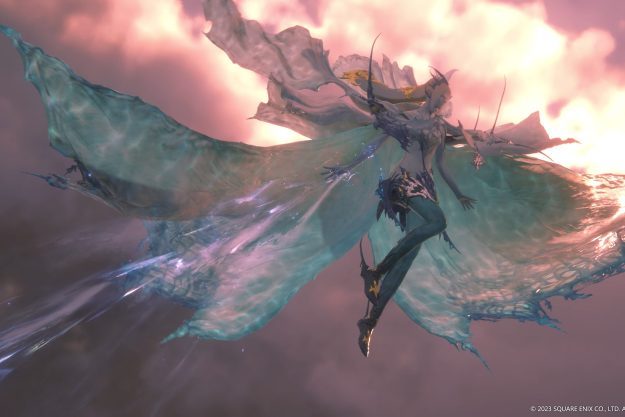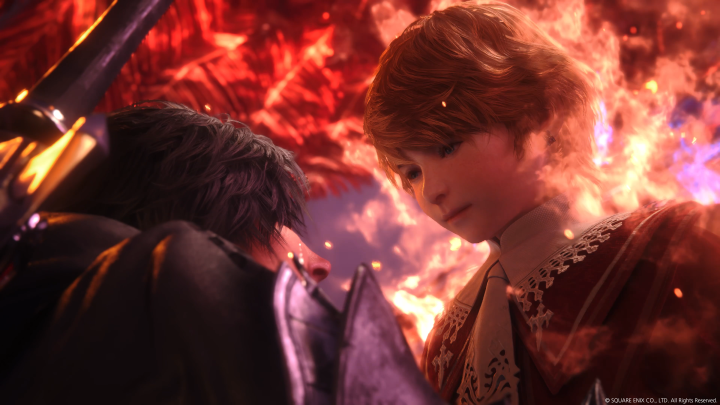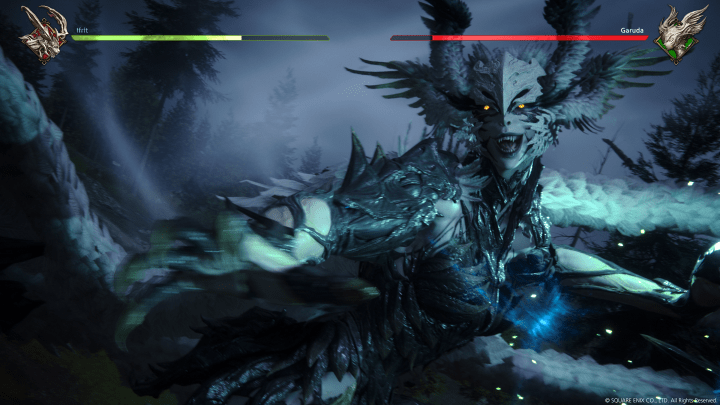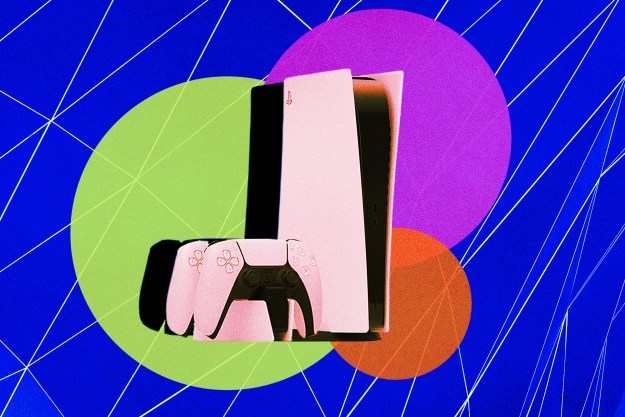
“Final Fantasy XVI delivers when it comes to spectacular action, but dated design and shallow RPG systems drag down a promising blockbuster.”
- Strong opening
- Excellent combat
- Incredible Eikon battles
- Impressive visuals
- Uneven story
- Disappointing character arcs
- Dull sidequests
- Shallow RPG systems
Clive Rosfield has a problem. Final Fantasy XVI’s broody hero is desperate to start a new life, one unburdened by the mistakes and trauma of his bloody childhood. No matter how hard he tries, though, he can’t fully escape the history weighing him down like an airship’s anchor. He’s not the only one struggling with that; one of his companions, Jill, is fighting that same battle.
“I want to live on my own terms,” she tells Clive midway through their adventure, “but first I must come to terms with my past.”
It’s a line that sticks with me as I play through Final Fantasy XVI, a game dealing with its own version of that identity crisis. Square Enix’s latest charts a new future for the long-running RPG franchise, confidently stepping into a more cinematic, action-packed territory that’s all the rage in Western video games these days. However, it can’t fully divorce itself from that past; its RPG instincts are still in its blood. Those two directions clash within the uneven fantasy epic like two towering summons duking it out.
Final Fantasy XVI delivers on the “action” side of its action-RPG formula. A fierce and fast-paced combat system makes for the series’ most exciting stab at real-time swordplay yet, while its blockbuster Eikon fights rank among some of gaming’s most awe-inspiring battles. But there’s a general flatness surrounding those exhilarating highs, as shallow RPG hooks and dated design leave a promising evolution for the series stuck in the past.
Video review
Game of Crystals
Set on the isolated continent of Valisthea, Final Fantasy XVI chronicles the story of its hero, Clive Rosfield, over several decades. In the first leg of his story, Clive is a bright-eyed young adult with a lot of responsibility: His royal family has sworn him to protect his younger brother, Joshua, who is the living embodiment of the Phoenix. The gripping opening act ends in tragedy, paving the way for a dark revenge story that almost plays out like Kill Bill with godlike “Eikons” (or summons, as we’ve known them in previous installments) in place of assassins.
The story works best when operating at its farthest extremes. The personal story of Clive trying to move on from a failure that defined his childhood gives the journey lots of thematic weight, asking how we move on and reclaim our lives after trauma. On the other hand, its enormous Eikons make for exciting self-mythology, turning long-running Final Fantasy staples like Ifrit and Shiva into genuine Gods. It’s a Greek myth seen through the lens of Hollywood blockbusters and inventive RPG worldbuilding.
A promising setup … fights for screen time with dull quests and indistinguishable characters …
It’s the space in between those two ideas that Final Fantasy XVI struggles in most — and that’s unfortunately where most of the story takes place. After around eight hours of following Clive’s quest for revenge, the narrative takes a left turn to dig into a grander, but more drab story about Valisthea’s warring kingdoms and the giant mothercrystals that rule over them. The development team behind the game hasn’t been shy about explaining how Game of Thrones shaped the story, and that shows. If you couldn’t see the influence in long soliloquies about political conflicts, you’ll certainly see it in the tired tropes it hoists upon its few, embarrassingly handled female characters.
It doesn’t help that Final Fantasy XVI has a dull approach to storytelling, with the bulk of its worldbuilding done through long conversations with dead-eyed NPCs. Sidequests especially strike out on that front, delivering dull content that seems uncharacteristically weak for a team that’s responsible for the beloved Final Fantasy XIV. The glut of side stories here are as by the books as they come, repeating the same few mission structures that herd Clive from NPC to NPC. Close to a dozen of the sidequests simply ask me to talk to someone, speak to three NPCs stiffly standing around a town, and then go back to the quest-giver for more lore. Others have me fast-traveling somewhere to fight a battle that’s sometimes over in as little as 30 seconds before throwing me into another lengthy chat. Rinse, repeat.

What’s often lacking is a diversity of thought, and that’s something that’s even reflected in its characters. In the lead-up to the game’s launch, reporters pressed the game’s creative team about the fact that Valisthea seemed to only be populated by white people. Producer Naoki Yoshida explained the decision, noting that despite being a fictional nation, it was very much based on European history. That reasoning doesn’t entirely add up in the final project considering that one of its kingdoms draws from Africa for design inspiration. But even if you buy that as a sensible explanation, it doesn’t explain why nearly every character I meet has the same body type and speaks in the same monotone, English droll. There’s little personality to the game’s cast, which makes it hard to differentiate its flat characters from one another.
That’s ultimately where the story loses me. A promising setup that expertly contrasts the personal with the mythological fights for screen time with dull quests and indistinguishable characters that at times feel like Square Enix sneaking some of its AI testing in to pad out the runtime with filler. As a character told me during one subquest, “If no one is listening to what you have to say, you may as well not say it.”
Eikonic action
While the story is uneven, its action is much more consistent. For nearly two decades, the Final Fantasy series has experimented with how to fully transition its turn-based RPG combat to a modern real-time action system. Final Fantasy XV and Stranger of Paradise: Final Fantasy Origin would try to push that further with middling results, while Final Fantasy VII Remake would start to crack at a satisfying system that still paid tribute to the series’ turn-based roots. Final Fantasy XVI offers the most confident approach to hack-and-slash combat we’ve seen from the series yet.
In addition to some basic sword combos and a dash, Clive can equip three different sets of magic, which can be mixed and matched. For instance, wind magic is largely built around fast aerial attacking, while Earth magic has him winding up heavy attacks with a bit of button timing. Each magic set has two attack slots and they operate on a short cooldown, bringing in a bit of the development team’s MMO expertise. With six spells to rotate between at any given time, Clive can chain together flashy attacks at a quick pace that make him control more like Dante from Devil May Cry than Cloud.

That system is further deepened by each magic set’s unique power, which can really let players build a playstyle that fits them. With fire magic equipped, pressing circle will cause Clive to dash forward, letting him close the gap on enemies and follow up with that magic set’s more close-ranged skills. Earth, on the other hand, turns circle into a block button that can parry enemy attacks when timed right. That leaves a safe window for Clive to charge up and land those slower rock attacks. I spent a lot of time during my journey trying to find the right mix of magic sets and skills that would all synergize with one another, letting me perform all six of my spells in one astonishing chain.
Some of the game’s flat design decisions do impact that strong system. Missions tend to repeat the same few enemy types and even recycle bosses with relative frequency, especially in side missions. Not a lot of enemies outside of optional, high-tier bounties require much strategy to beat. I mostly spammed spells the same way during just about every fight, with no need to switch things up. There’s a good reason that some of the best character-action games wrap up in 10 hours. Still, combat is so stylish and enjoyable that I’m rarely upset about getting more opportunities to see how fast I can get a big enemy’s stagger bar down.
Almost every Eikon battle here could be a candidate for one of the top 10 best video game bosses of all time.
The most extraordinary piece of its combat, though, comes from its Eikon brawls. Throughout the story, Clive awakens his own inner demon and goes toe-to-toe with kaiju-sized monsters in jaw-dropping cinematic battles. These fights make up all of Final Fantasy XVI’s best and most varied moments. An opening fight against Ifrit has me controlling Phoenix in a Panzer Dragoon-like shoot-’em-up. A later fight with Titan has me zipping around a halfpipe like Sonic the Hedgehog, avoiding flying boulders along the way — and that’s just one phase of an epic, ever-changing 30-minute encounter.
Each battle tells its own unique saga through spectacular action, showing that the creative team has a true gift for visual storytelling. Were this a focused 10-hour action game that mostly built up to that handful of fights, it would be one of the series’ crowning achievements. But there’s 40 more hours of game around that … and it isn’t nearly as gripping.
Split priorities
Playing Final Fantasy XVI, I get the sense that I can feel exactly where the project’s budget went. Those incredible Eikon battles, presented with some of the most astonishing visuals we’ve seen on the PlayStation 5 to date (though not without some performance hiccups), stand in sharp contrast to dated characters and barren world design. That last part is especially a drag, as all major quests take place in completely linear areas that reuse assets from empty room to empty room. The more open-field areas don’t fare much better, as there’s virtually no reason to explore an area’s nooks and crannies. It’s just extra space that’s barren until the right subquest triggers, giving the illusion of exploration. A lot of these problems were sticking points of Final Fantasy VII Remake, but the problem is worsened here.
If it didn’t have a beloved brand attached, would the project have nearly the same gravitas?
The more I played, the more I began to question why so little was engaging me outside of Eikon battles. Not too long into my journey, I’d find that a lot of my problems came back to one thing: shallow RPG hooks. Though Final Fantasy XVI is being positioned as an action-RPG, the latter half of that genre hybrid is severely overstated. There’s leveling up, stats, and a few equipment slots, but a lot of its systems are a placebo hiding an entirely restrictive approach to power. For instance, Clive has six stats, but look closely and you’ll realize that three of those aren’t really stats at all. Strength, for instance, is actually just Clive’s attack stat combined with an extra buff he’s getting from equipped gear. It’s smoke and mirrors that hides the fact that Clive’s power progression is fairly static from start to finish.
That idea is present in all of its systems and they weaken several other aspects of the game as a result. For instance, Clive can buy, forge, and upgrade new weapons to increase his power and defense throughout the game. There’s not really much choice here, though. There’s always one sword or belt that is objectively better than everything else available at that moment. There’s no reason to spend much gold or waste the glut of resources Clive earns throughout the story. By the end of the game, I ended up with more money and materials than I could ever hope to spend. And guess what the reward for exploring fields or completing those dull sidequests usually are: gold and crafting resources.

So what reason am I given to engage with most of the content here? With a constant war chest of gold and hundreds of fangs that I will never have a reason to use, much of the game ends up feeling like busy work. I did every sidequest out of the same brain addiction that has me checking off map activities in open-world games I don’t even enjoy. Only 10 or so sidequests actually yield any reward worth obtaining, like chocobo riding or increased potion capacity, so why bother with the rest just to get more dry worldbuilding that grinds the story’s momentum to a halt? It’s all air in the potato chip bag.
Large parts of Final Fantasy XVI feel like they were designed more out of obligation than anything. It’s as if the developers wanted to make a pure character action game, but feared that it would be a drastic change that longtime fans couldn’t accept. It all makes for a game that at once feels like a bold new future for the series and a dated step back that plays like 2010’s Nier minus the ahead-of-its-time storytelling that’s allowed it to live on as a cult classic.
Considering how lukewarm — hostile, even — players have been on some of Square Enix’s original IP in the past year, all of this has me running a series of “what if” scenarios through my head. If it didn’t have a beloved brand attached, would the project have nearly the same gravitas? Or would it float by like The Diofield Chronicles before it? I keep trying to picture what the conversation would be right now if this was revealed on a Sony State of Play with the title Eikonic Legacy instead of Final Fantasy XVI. I could care less about whether or not this is a “true” Final Fantasy game; the only thing that’s consistent about the series is its shapeshifting nature, after all. By that same token, though, I can only judge this form entirely on its own terms. And regardless of its title and the legacy it holds, this installment is rife with structural issues that I can’t wipe away with brand name nostalgia.

Despite these grievances, I do think there’s a bright future for the series in this reworked format. The world of Valisthea is rich with intriguing mythology, the strong combat system makes up for some of the customization lost in the weak RPG hooks, and almost every Eikon battle here could be a candidate for one of the top 10 best video game bosses of all time. Just as Clive yearns to close the book on his past and start anew, I hope Final Fantasy can do the same and evolve into a confident, focused action game unburdened by any expectations attached to the series or its RPG label.
Let the Phoenix die, for it will always rise again anew.
Final Fantasy XVI was reviewed on a PS5 hooked up to a TCL 6-Series R635.
Editors' Recommendations
- PS5 Pro: news, rumored release date, price, and specs
- All upcoming PS5 games: 2024 and beyond
- Best PS5 game deals: discounts on the best games of 2023
- The 5 best HDMI cables for PS5 in 2024
- When will Final Fantasy 7 Rebirth be on PC?




